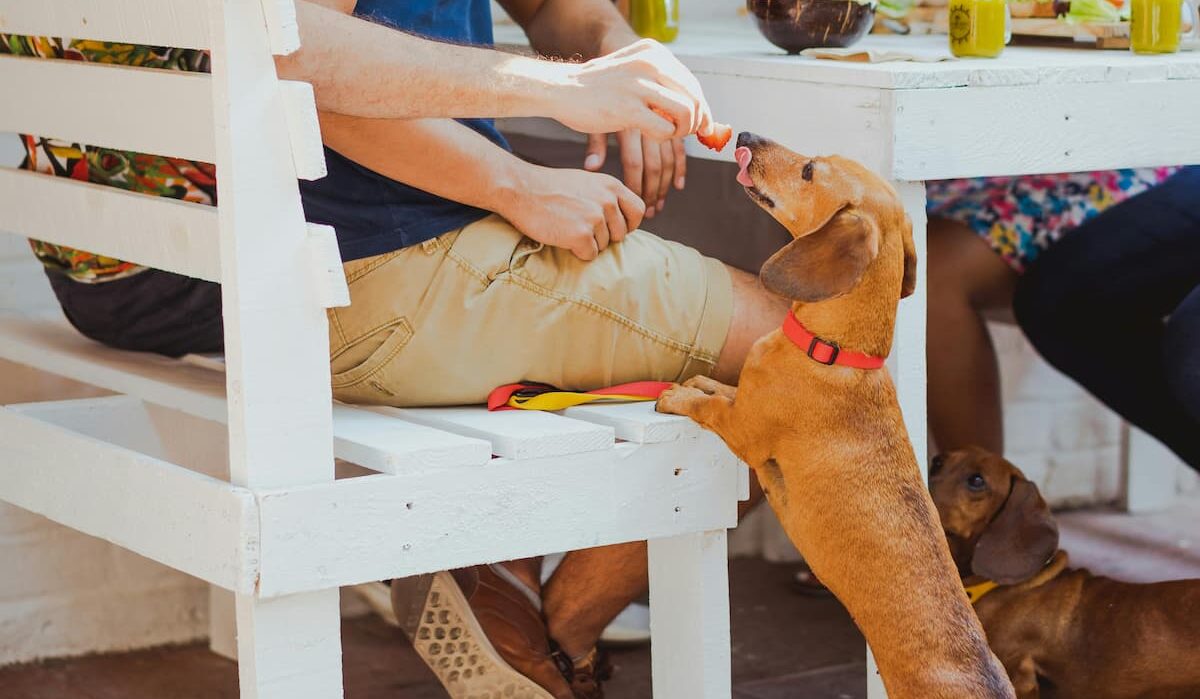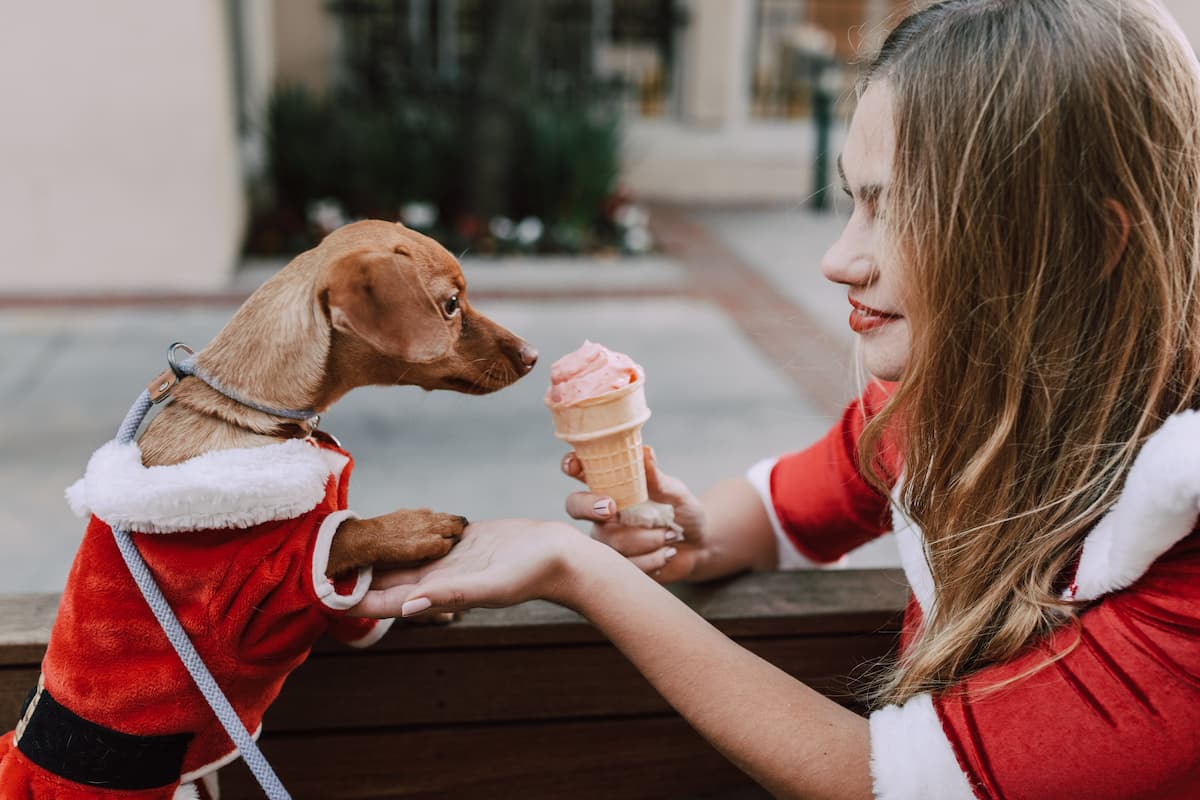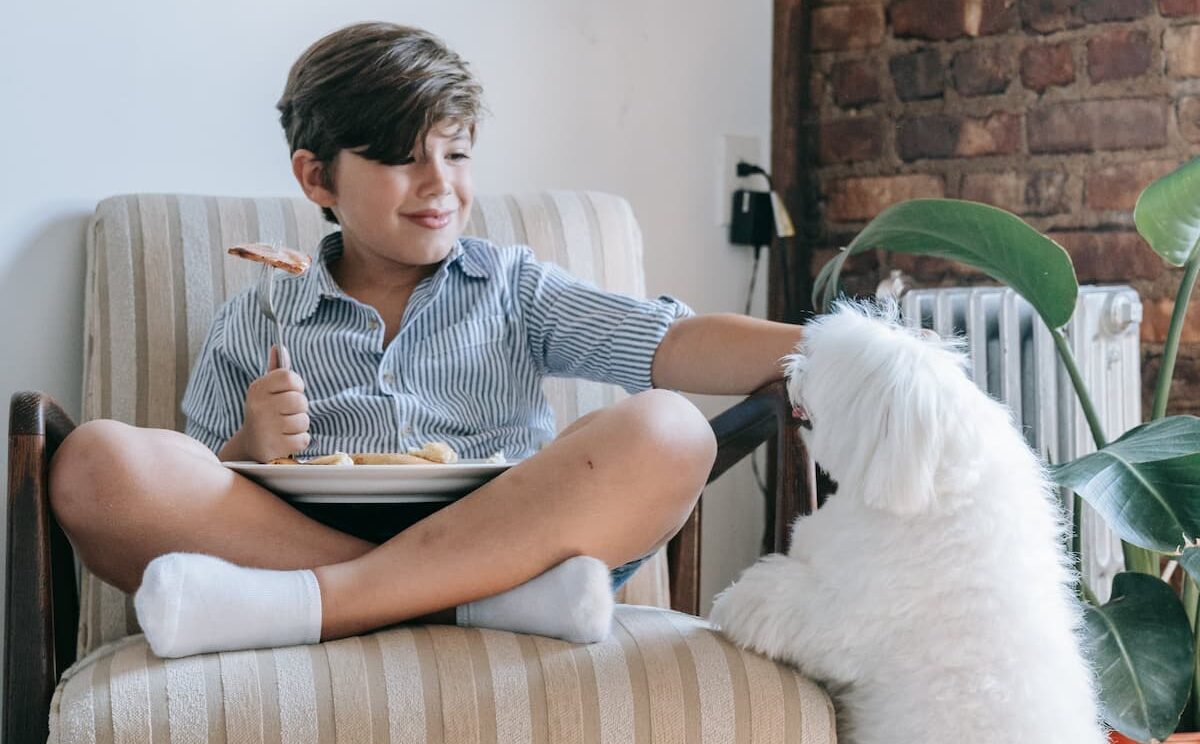Have you ever wondered why your beloved furry friend always has their eyes on your plate, just waiting for the perfect opportunity to snatch a morsel of your food?
You’re not alone! It seems like dogs have an insatiable appetite for our scrumptious meals.
From stealthily stealing that cheesy pizza slice on the coffee table to shamelessly drooling over your juicy burger, they’ll go to great lengths to get their paws on some good grub.
But what drives this canine desire for human food?
This article will answer your questions.
Understanding the Canine Instinct About Why do Dogs Want our Food?
Dogs have a reputation for being the ultimate beggars when it comes to human food.
One look into their soulful eyes, and it’s hard not to give in to their persistent cravings.
But why exactly do our furry friends have such a strong desire for our food?
It all boils down to their innate instinct and a few fascinating reasons you may not have considered before.
First and foremost, dogs are descendants of wolves, who were natural scavengers.
They would eat whatever they could find, including the leftovers from human hunts.
Over time, this scavenging behavior has been ingrained into their DNA, making them highly adaptable and resourceful when it comes to seeking out food.
So, when they catch a whiff of that delicious meal you’re enjoying, their natural instincts kick in, driving them to try and secure some sustenance for themselves.
Secondly, our dogs are incredibly social creatures.
They see us as their pack leaders and want to be a part of everything we do, including mealtime.
Your furry companion wants to be as close to you as possible, which is why they beg at the dinner table.
It’s not just about the food; it’s about the communal aspect of sharing a meal and being a valued member of the pack.
So, when they see you enjoying a tasty treat, they feel left out and crave that connection with you.
Lastly, dogs simply have a more heightened sense of smell than we do.
Their olfactory receptors are far more powerful, allowing them to detect the tantalizing aroma of your food from a distance.
It’s like they have a built-in radar that detects every little scent particle in the air.
So even if you try to hide your food in your purse or bury it under a pile of clothes, chances are your dog will still find it.
Their nose leads them on a wild food-hunting adventure, and no meal is off-limits in their pursuit of gastronomic delight.
Their sense of smell also ties into their taste.
While dogs have fewer taste buds than humans, they have a heightened sense of smell, which compensates for the lack of taste receptors.
This means that the aromas of your food are incredibly enticing to them.
Additionally, certain foods may also activate their taste buds in a way that their regular kibble may not.
It’s no surprise that our table scraps often have a more potent smell and flavor that can drive their taste buds wild.
But it’s not just instinct that drives dogs to beg for our food; there are also genuine nutritional deficiencies that could be at play.
While commercial dog food provides the essential nutrients dogs need, it may not always satisfy their cravings for certain flavors or textures, and just like us, they have preferences in what they want to eat.
So, if they’re constantly seeking out our food, it could be because they’re missing something in their diet that they hope to find in our meals.
Tips and Tricks for Managing Your Dog’s Food Envy
To manage your dog’s food envy and prevent counter surfing, it’s crucial to establish boundaries and maintain consistent feeding habits.
Here are some helpful tips:
– Designate a specific feeding area for your dog, preferably away from the kitchen or dining room.
This will create a designated space for meals, reinforcing a sense of routine and structure.
– Stick to a regular feeding schedule.
Dogs thrive on routine, and knowing when to anticipate their meals can help reduce their food envy.
Aim to feed your furry friend at the same times each day.
– Avoid feeding your dog directly from the table.
While it may be tempting to share tidbits with your four-legged companion, this can reinforce their food envy and encourages begging behavior.
Instead, prepare healthy, dog-friendly treats in advance and offer them during training sessions or as rewards for good behavior.
– Invest in puzzle toys or food-dispensing toys.
These interactive toys engage your dog’s natural instincts, providing mental stimulation while rewarding them with a tasty treat.
This can help redirect their attention from your plate to their own entertainment.
– Despite their strong desire for our food, it’s important to remember that dogs have dietary needs that differ from our own.
While certain human foods can be safe for them in moderation, it’s crucial to understand that a well-balanced meal plan tailored to their nutritional requirements is essential.
By providing your furry friend with a carefully curated diet, you ensure they receive all the necessary vitamins, minerals, and nutrients to promote good health and longevity.
While it’s tempting to share a bite, it’s best to stick to their specially formulated meals to meet their dietary needs.
Remember, managing your dog’s food envy is a journey that requires patience and consistency.
By understanding their instincts, establishing boundaries, and providing alternative sources of entertainment, you can nurture healthy feeding habits and create a harmonious dining experience for both you and your beloved canine companion.
A happy and satisfied pup always starts with a well-planned meal plan designed to keep them healthy and thriving.
FAQ
Q: So, why exactly does our furry friend always eye our food with those longing puppy eyes?
A: First things first, let’s remember that dogs are natural-born scavengers.
Back in the day, when they roamed the wild, searching for food was their primary means of survival.
So, it’s only natural that this instinctual behavior has carried over to our modern-day companions.
Q: But is it just about survival instincts, or is there more to it?
A: Absolutely!
While dogs are undoubtedly motivated by the primal urge to eat anything that looks remotely appetizing, there’s more to it than meets the eye.
Dogs are social beings, and they see us as part of their pack.
When you’re munching away, sharing that delightful aroma, they don’t want to be left out.
It’s all about bonding and being a part of the group.
Q: That makes sense.
But why do they seem to pay extra attention to certain foods, even if it’s something they can’t eat?
A: Ah, good question!
Dogs, much like humans, have preferences when it comes to food.
They may be drawn to certain smells or flavors that pique their interest.
Plus, let’s not forget those irresistibly tantalizing human treats that dogs just can’t resist sniffing out.
Even if they can’t actually eat them, their curiosity still gets the best of them.
Q: Are there any other reasons why dogs go after our food?
A: Well, let’s not underestimate their incredible sense of smell.
Dogs have olfactory capabilities far superior to ours, and they can detect the tiniest whiff of food from miles away (or so it seems!).
So, when they catch a whiff of that mouthwatering scent, their noses and taste buds go into overdrive, leaving them eager to investigate and possibly snag a bite.
Q: Is it okay to give our dogs some of our food?
A: While it’s tempting to share a taste of our meals with our furry companions, we need to be cautious.
Some human foods can be harmful or toxic to dogs, so it’s crucial to educate ourselves about what’s safe for them to consume.
If you want to treat your pooch, opt for dog-friendly alternatives or consult with your veterinarian to ensure you’re not unintentionally putting your pet’s health at risk.
Q: How can we discourage this behavior if we don’t want our dogs constantly begging for our food?
A: Ah, the million-dollar question!
Consistency and training are key.
Establish boundaries from an early age and enforce them consistently.
Teach your dog to wait patiently during mealtime, preferably in their designated area.
You can also provide chew toys or special treats to distract and reward them.
And remember, never give in and reward begging behavior, even when those puppy eyes test your resolve!
By understanding why dogs are so eager to get their paws on our meals, we can find ways to address and manage their behavior without compromising their happiness.
With a bit of training, patience, and lots of love, you and your canine companion can enjoy mealtimes without those longing puppy eyes begging for every last bite!
Bringing it All Together
From begging eyes to pesky paws, our dogs have an uncanny ability to sniff out and crave our food.
But why?
Well, we’ve discovered that it all boils down to their evolutionary history and their knack for survival.
It’s in their genes to scavenge for scraps, dating back to their wild ancestors who had to rely on hunting and scavenging for their next meal.
But let’s not forget about those irresistible aromas that waft through the air and make our mouths water.
Dogs have a sense of smell that puts ours to shame, and those delicious scents are simply irresistible to them.
So when they catch a whiff of that sizzling bacon or that freshly baked pie, it’s no wonder they come running towards the kitchen like a lightning bolt!
However, it’s essential to remember that the responsibility falls on us, the humans, to set healthy boundaries and teach our furry companions some self-control.
While handing them a tasty morsel from our plate once in a while won’t harm them, we must avoid reinforcing bad habits or inadvertently encouraging unwanted behavior.
Establishing clear rules and boundaries when it comes to sharing food is crucial for the wellbeing and overall manners of our canine companions.
So the next time your four-legged buddy gives you those puppy eyes and tries to snatch a bite off your plate, remember that it’s not just about their love for food – it’s in their nature.
Let’s appreciate their innate instinct, but also make sure we’re teaching them proper dining etiquette.
With a little bit of understanding and training, we can reinforce a harmonious relationship between us and our beloved pups, even during mealtime.
So bon appétit, and happy sharing, everyone!














